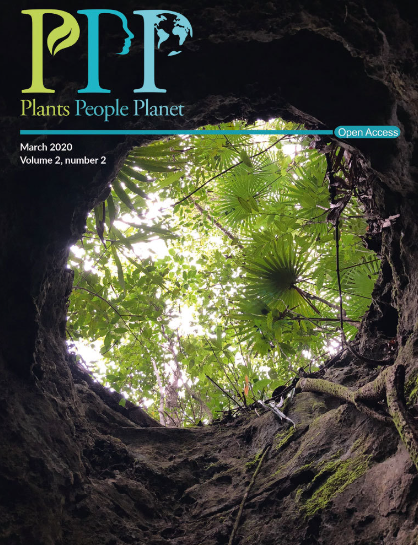双CRISPR敲除果胶降解酶提高番茄保质期,同时确保水果品质
IF 3.6
2区 环境科学与生态学
Q1 BIODIVERSITY CONSERVATION
引用次数: 0
摘要
番茄果实是一种重要而受欢迎的商品,在全球的产值为956.2亿美元。番茄果实在供应链中的损失在25%到42%之间,具体取决于生产区域和采后技术的可用性。几十年来,传统的番茄育种计划一直专注于延长新鲜市场品种的保质期。然而,在许多情况下,以消费者为基础的质量特征并没有被视为优先考虑的因素。消费者现在需要安全、营养丰富、高风味和方便的水果。在这里,我们展示了使用基因编辑来提高水果保质期和积极影响质量,这可以帮助显著减少番茄果实损失,满足消费者的期望。寻找在不降低质量的情况下延长番茄水果保质期的替代方法对于确保这种商品在全球范围内的可及性和受欢迎程度至关重要。提高新鲜市场番茄品种的果实硬度直接影响其货架寿命潜力。我们同时敲除了两种果胶降解酶,聚半乳糖醛酸酶(SlPG2a)和果胶裂解酶(SlPL),它们是番茄果实软化的关键。我们期望这种基因编辑方法能够产生更持久的水果,而不会对以消费者为基础的质量属性产生负面影响。通过生成双聚类规则间隔短回文重复序列(CRISPR)敲除的PGPL,我们评估了SlPG2a和SlPL对水果品质的综合功能,包括硬度和失水等货架寿命属性、水果的市场性和发病率。我们还评估了影响消费者接受度的其他属性,如味道和香气。我们发现SlPG2a和SlPL酶加在一起作用,显著影响果实的硬度和保质期,双CRISPR敲除的PGPL优于野生型果实。此外,与野生型相比,双CRISPR敲除PGPL的果实品质性状,如糖酸比、香气挥发物和皮肤颜色,都得到了改善或没有受到影响。本研究的发现为果胶骨架降解对水果生理和采后品质的影响提供了新的见解,可用于作物改良计划,使水果在供应链中更具弹性,同时不影响质量。本文章由计算机程序翻译,如有差异,请以英文原文为准。
Double CRISPR knockout of pectin degrading enzymes improves tomato shelf‐life while ensuring fruit quality
Social Impact Statement Tomato fruit is an important and popular commodity producing $95.62 billion worldwide. Tomato fruit losses in the supply chain vary between 25% and 42% depending on the production area and the availability of postharvest technologies. For many decades, conventional tomato breeding programs have focused on extending the shelf‐life of fresh‐market varieties. However, in many instances, consumer‐based quality traits were not considered a priority. Consumers are now demanding safe, nutrient‐rich, high‐flavor, and convenient fruit. Here, we demonstrate the use of gene editing to improve fruit shelf‐life and positively impact quality, which can help significantly reduce tomato fruit losses and meet consumer expectations. Summary Finding alternative ways to extend tomato fruit shelf‐life without reducing the quality is critical to ensure the accessibility and likeability of this commodity worldwide. Improving fruit firmness in tomato fresh‐market varieties directly impacts their shelf‐life potential. We simultaneously knocked out two pectin‐degrading enzymes, polygalacturonase (SlPG2a) and pectate lyase (SlPL), key for tomato fruit softening. We expected this gene‐editing approach to result in longer‐lasting fruit without negatively impacting consumer‐based quality attributes. By generating the double clustered regularly interspaced short palindromic repeats (CRISPR) knockout PGPL, we evaluated the combined functions of SlPG2a and SlPL on fruit quality, including shelf‐life attributes like firmness and water loss, fruit marketability, and disease incidence. We also assessed additional attributes impacting consumer acceptance, such as taste and aroma. We revealed that the enzymes SlPG2a and SlPL act additively, significantly impacting fruit firmness and shelf‐life, with the double CRISPR knockout PGPL outperforming the wild‐type fruit. Additionally, fruit quality traits, such as sugar: acid ratio, aroma volatiles, and skin color, were improved or not affected in the double CRISPR knockout PGPL compared to the wild‐type. The discoveries of this research provide new insights into the influence of pectin backbone degradation on fruit physiology and postharvest quality, which can be used in crop improvement programs to make fruit more resilient in the supply chain without compromising quality.
求助全文
通过发布文献求助,成功后即可免费获取论文全文。
去求助
来源期刊

Plants People Planet
Multiple-
CiteScore
9.90
自引率
5.90%
发文量
81
审稿时长
12 weeks
期刊介绍:
Plants, People, Planet aims to publish outstanding research across the plant sciences, placing it firmly within the context of its wider relevance to people, society and the planet. We encourage scientists to consider carefully the potential impact of their research on people’s daily lives, on society, and on the world in which we live. We welcome submissions from all areas of plant sciences, from ecosystem studies to molecular genetics, and particularly encourage interdisciplinary studies, for instance within the social and medical sciences and chemistry and engineering.
 求助内容:
求助内容: 应助结果提醒方式:
应助结果提醒方式:


